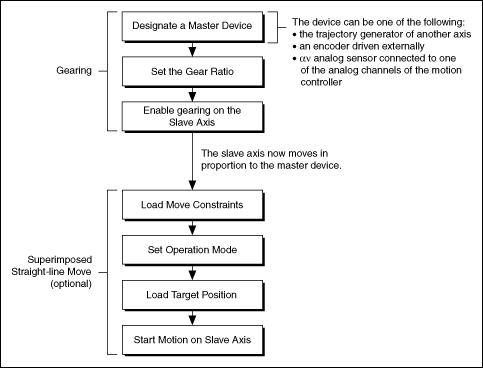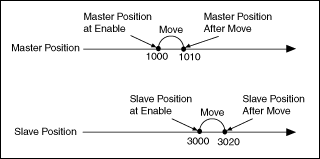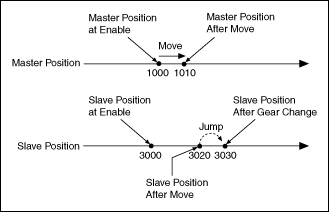Gearing
Electronic gearing allows one slave motor to be driven in proportion to a master motor or feedback sensor, such as an encoder or torque (analog) sensor.
As the slave follows the master position at a constant ratio, the effect is similar to that of two axes mechanically geared.
Electronic gearing has several advantages over mechanical gears. The most notable is flexibility because you can change gear ratios on-the-fly. The other major advantage to electronic gearing is that you can superimpose a move over a geared axis. The superimposed move is added to the geared profile of the slave axis, which allows the slave axis to be synchronized on-the-fly.
An axis can be geared to another axis, or to an encoder or ADC. When you gear an axis to another axis, the slave axis follows the trajectory generation of the master axis. For example, if you manually move the master axis, the slave axis does not move because the trajectory generator of the master axis is not active.
When you gear an axis to an encoder, or feedback device, the slave axis follows the feedback generated by the encoder. If the encoder detects movement, the slave moves proportionally to information returned by the encoder. For example, if you twist the master axis connected to the encoder, the slave axis also turns because it is using the position information gathered by the encoder.
When an axis is geared to an ADC, the slave axis follows the binary value of the ADC as if it were a position. For example, if the binary code for 2 V is 6553, the slave axis tracks to this position.
Electronic Gearing Algorithm
The following figure shows a generic electronic gearing algorithm applicable to both C/C++ and LabVIEW code.

Absolute versus Relative Gearing
The gear ratio is used to determine how far the slave axis must move in proportion to the master when gearing is enabled. The gear ratio can be absolute or relative.
Slave axis move = Master axis position × Gear ratio
Relative Gearing
Relative gearing allows you to change the gear ratio on-the-fly. The master move is calculated based on the master reference position, which is updated when gearing is enabled and is updated each time a new gear ratio is loaded. For example, if you have a gearing ratio of 2:1 (slave:master), the slave moves 20 counts when the master device moves 10 counts.

Absolute Gearing
Absolute gearing behaves similarly to relative gearing in that when gearing is enabled, the slave axis follows the master axis movement as it is defined by the gear ratio. The difference between relative and absolute gearing is that the reference position calculated for the master axis is updated only when gearing is enabled. This difference is apparent when the gear ratio is updated on-the-fly.
For example, if the gear ratio is 2:1, the current master position is 1010, the current slave position is 3020, and the gear ratio is changed to 3:1, the slave axis jumps from 3020 to 3030 but the master position remains the same.

Changing a gear ratio on-the-fly during absolute gearing allows you to quickly synchronize the slave axis with the master axis.
 |
Note When the gear ratio is changed on-the-fly, the slave axis moves at full torque to the new position. |